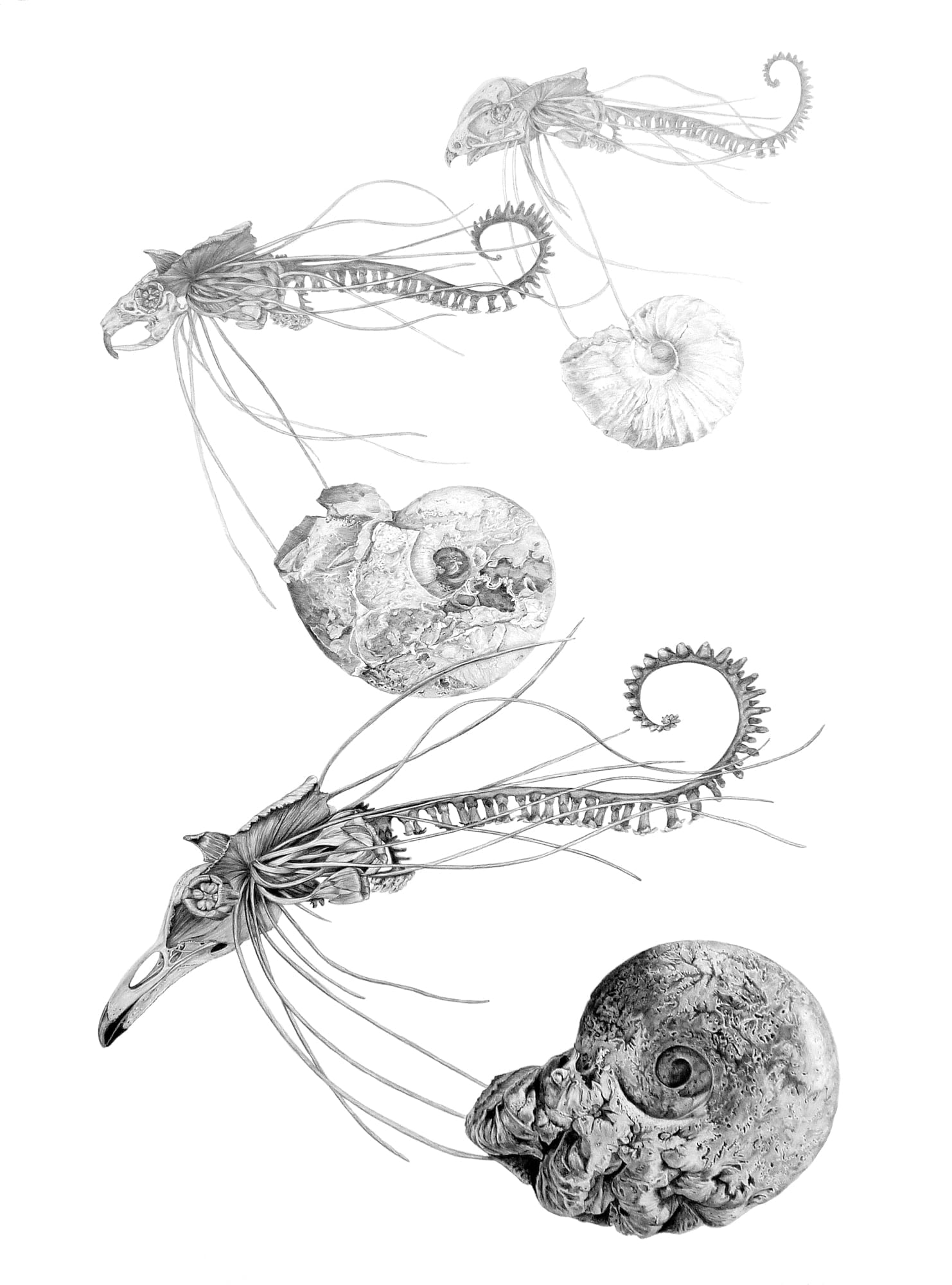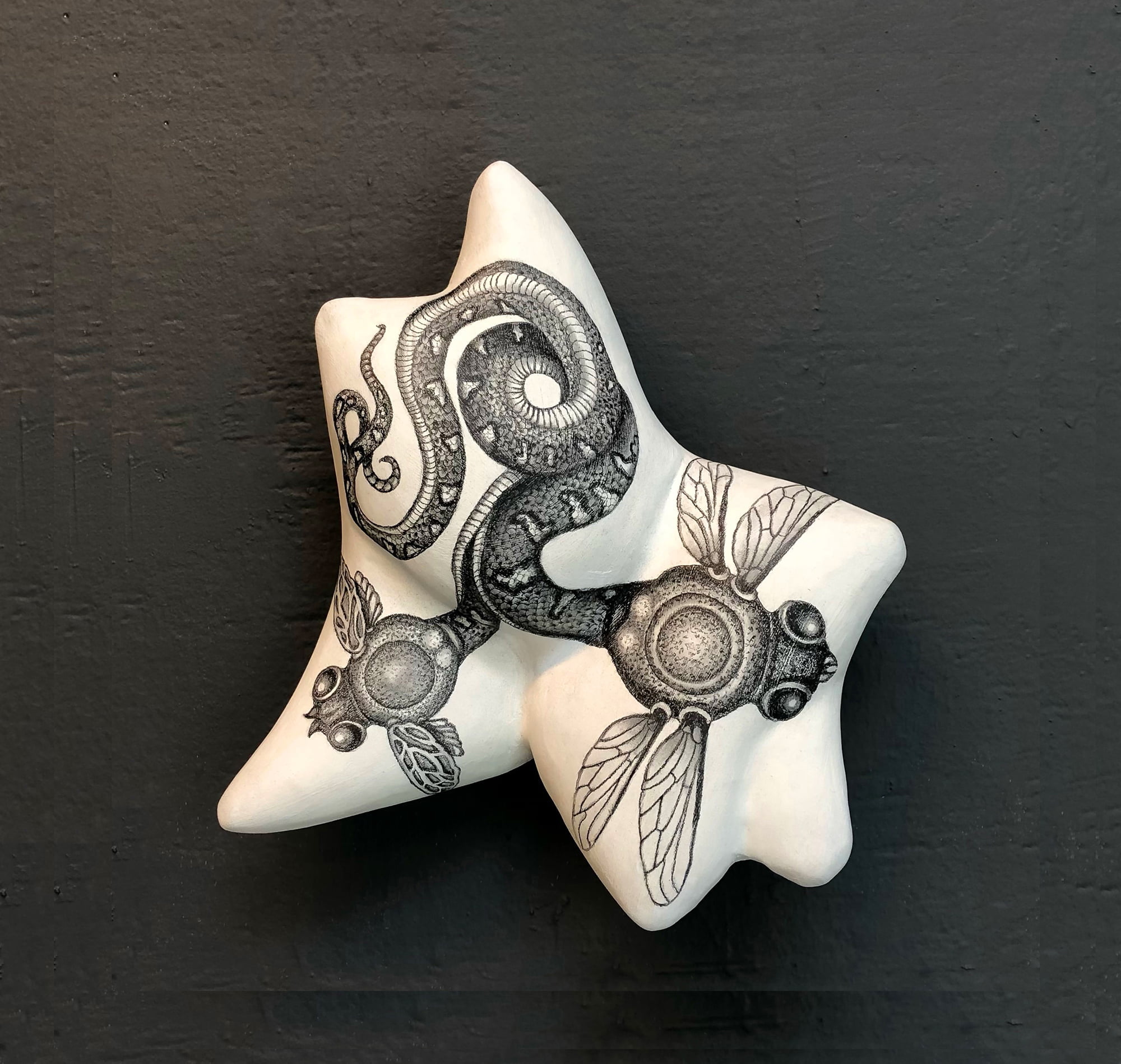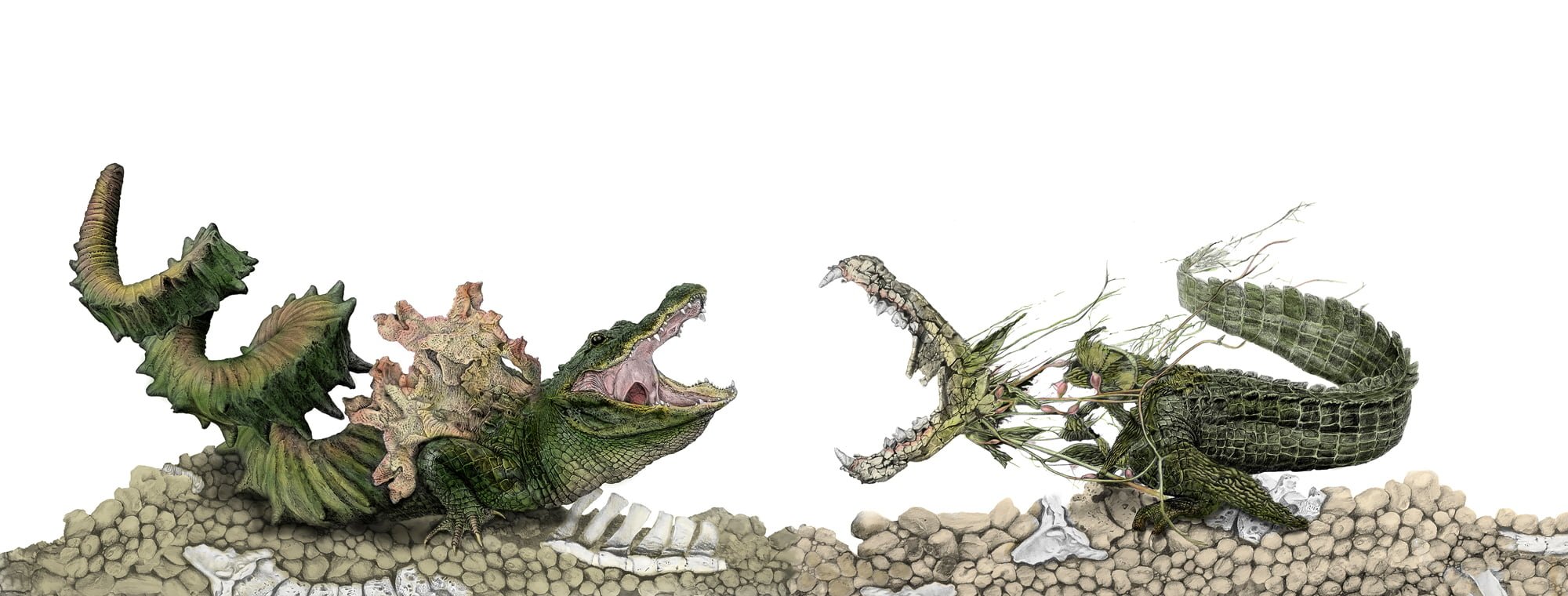Mediums Graphite, paint, ceramic
Studio Bakehouse Art Complex
Recent Show
San Angelo Museum of Fine Arts, Texas
Which artwork is the most personally meaningful to you?
The drawing "Burden" is towards the top of this list, because one of my biggest concerns is the ongoing destruction of life within our seas, both from direct elimination of species by humans and increasing acidification, which affects every living thing in them. Burden envisions mechanisms for survival in this inhospitable environment. In this piece, the imagery for the ‘burdens’ is based on fossil ammonites, a species that was ubiquitous through the oceans and is now extinct, as many aquatic species are currently heading for extinction. Below is the brief story for "Burden":[Excerpt from: The Journal of Biological Exploration sometime in the far distant future…]A drone submersible photographed these creatures floating in the sea currents above the Grand Canyon Trench. It is not clear whether these specimens are one organism, or two organisms having a symbiotic or parasitic relationship. Scientists speculate that the large lower ‘burdens’ may be a mobile food source, removing the necessity of constantly finding food in these barren seas.

Burden Graphite on paper 41"H x 30"W
Is there a piece that signifies a breakthrough for you?
"Adaptation", the first piece that I created in my Biological Futurism series, was a breakthrough piece. With this drawing, I started to imagine what creatures might exist after the Anthropocene, and how they would evolve to adapt to the changing environment, rising sea levels etc. It was the first large graphite piece that I had ever done, and the first where I wrote a story -a paragraph, really- in a fictional future scientific journal describing what was happening in the drawing. The combination of drawing and writing has continued throughout this series. Here's the brief story for "Adaptation":[Excerpt from: The Journal of Biological Exploration sometime in the far distant future…]This unique creature was discovered in the shallow bay covering the island of Manhattan. The tentacles collect food which is then filtered by the two large, fleshy organs on each side. These organs, which apparently developed from a terrestrial species, have in turn become the food of the sea tiger.

Adaptation Graphite on paper 33”H x 26”W
Is there an artwork you’ve made that surprised you?
I’ll tell you a secret… every time I make a piece it surprise me; I learn something with each and every one. For me, drawing is a process of pulling the image out of the paper or sculpture's surface, and though I plan meticulously, it is always a surprise when it finally emerges. Recently I’ve been making collaborative pieces with artist Bryan Hiveley. He creates the base sculpture, and then I create the drawing on it, using the sculptural elements to influence the imagery. It is a challenge conceptually and technically, and totally different than working on a flat surface. The surprise comes when it is completed and can be viewed from many angles. "Gemini Diverging" is a wall piece, and the imagery shifts changes as you look at it from different angles.

Gemini Diverging Graphite on ceramic 14"W x 14"H x 6"D
Is there a piece that is conveying a specific message to the viewers?
Hopefully, all my pieces convey the message about what we are doing to our environment, and the long-reaching consequences of what could result, as imagined in "Specimen #17". Here's the brief story for this work:[Excerpt from: The Journal of Biological Exploration sometime in the far distant future…]Insectus planticus is one of the new hybrid animal/plant forms that are appearing in the barren regions where rainforests used to be abundant. The insect hybrid shown here is one of a class of insects that have developed the ability to photosynthesize, thus eliminating the need to feed on plant matter, a useful adaptation in a defoliated landscape.

Specimen #17 Mixed media 22"H x 30" W
What attribute of a work do you hope strikes the viewer?
Could these creatures exist? That is the question. I always hope that the viewer finds the animals and plants that inhabit the works believable, and that the detail draws them in and convinces them of its possibility. For instance, “Rivals" is a diptych based on imagining the future of present-day alligator. Portions of the alligator are readily recognizable, but evolution has taken these two beasts in different directions. I pretend that I’m a scientist of the future, and want to take the viewer on the journey with me.

Rivals (Diptych) Mixed media Each 18"H x 30"W
Tell us about a recent commission? The scope, challenges, end result, etc
I love doing commissions of fossils and reptiles for scientists. An illustration of a beloved subject for someone who is an expert must be absolutely accurate. Though the two images below were not as large as some of my other detailed graphite drawings, the amount of detail made it extremely challenging to keep track of exactly where I had left off in the previous session!This type of work contributes to my art practice both directly and indirectly, as someday in everything that exists today may be fossils, and I use fossil imagery in my imagined future. After an illustration is done, I can alter the image, disassemble and reassemble it digitally, overlay it with patternong, color it outrageously- whatever my heart desires.Dailyatia, the aquatic micro-fossil shown here, is about 500 million years old (!) and can really only be examined with a microscope. I drew both the side and front views at thousands of time its actual size, enabling the graceful form of the fossil to seen by any viewer of the work.

Dailyatia Graphite on paper Each view about 12"H x 9"W

